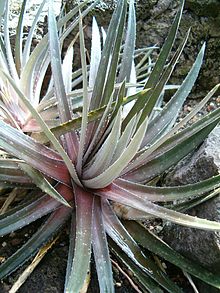| Dyckia | |
|---|---|
 | |
| Dyckia maracasensis | |
| Scientific classification | |
| Kingdom: | Plantae |
| Clade: | Tracheophytes |
| Clade: | Angiosperms |
| Clade: | Monocots |
| Clade: | Commelinids |
| Order: | Poales |
| Family: | Bromeliaceae |
| Subfamily: | Pitcairnioideae |
| Genus: | Dyckia Schult.f. |
| Synonyms [1] | |
| |
Dyckia is a genus of plants in the family Bromeliaceae, subfamily Pitcairnioideae.
Contents
The genus is named after the Prussian botanist, botanical artist and horticulturist The Prince and Earl of Salm Reifferscheid-Dyck (1773–1861).
Dyckias, with stiff and thorny leaves, prefer rocky and/or sunny areas and have a natural tendency to clump leading to thick, large mats.
The subfamily Pitcairnioideae contains several "terrestrial" members of the Bromeliaceae, with cultivated genera including Dyckia, Hechtia , Pitcairnia and Puya . They are endemic to arid and high-altitude regions of Brazil and the central part of South America. [1] [2] [3]





